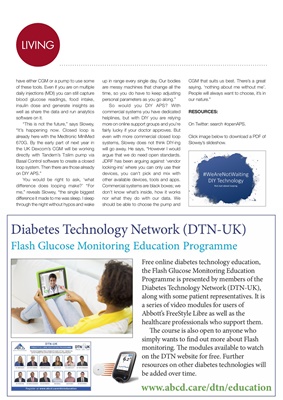
LIVINGLIVING
have either CGM or a pump to use some
of these tools. Even if you are on multiple
daily injections (MDI) you can still capture
blood glucose readings, food intake,
insulin dose and generate insights as
well as share the data and run analytics
software on it.
"This is not the future," says Slowey,
"It's happening now. Closed loop is
already here with the Medtronic MiniMed
670G. By the early part of next year in
the UK Dexcom's CGM will be working
directly with Tandem's T:slim pump via
Basal Control software to create a closed
loop system. Then there are those already
on DIY APS."
You would be right to ask, 'what
difference does looping make?' "To
me," reveals Slowey, "The single biggest
difference it made to me was sleep. I sleep
through the night without hypos and wake
up in range every single day. Our bodies
are messy machines that change all the
time, so you do have to keep adjusting
personal parameters as you go along."
So would you DIY APS? With
commercial systems you have dedicated
helplines, but with DIY you are relying
more on online support groups and you're
fairly lucky if your doctor approves. But
even with more commercial closed loop
systems, Slowey does not think DIY-ing
will go away. He says, "However I would
argue that we do need open standards.
JDRF has been arguing against 'vendor
locking-ins' where you can only use their
devices, you can't pick and mix with
other available devices, tools and apps.
Commercial systems are black boxes; we
don't know what's inside, how it works
nor what they do with our data. We
should be able to choose the pump and
CGM that suits us best. There's a great
saying, 'nothing about me without me'.
People will always want to choose, it's in
our nature."
RESOURCES: On Twitter: search
#openAPS. Click image below to
download a PDF of Slowey's slideshow.